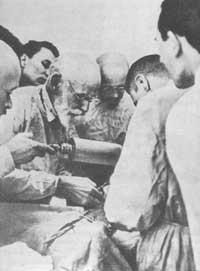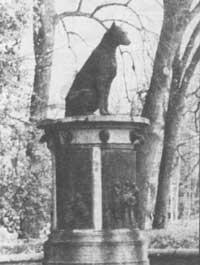Ivan Pavlov, the world's most famous physiologist
Ivan Pavlov (Riazan-Russia 1849-Leningrad 1936) is the founder of the materialist theory on high level nervous activity. Pavlove has played a very important role in the field of natural sciences, both in detecting the laws of brain activity and in solving the most difficult problems of biology and medicine.

In 1904 he was awarded the Nobel Prize, being the first to receive this Prize in the world. He was also elected a member of 22 scientific academies and an honorary member of various national and international scientific associations. It was held in 1935. At the Congress of Physiology he was appointed “dean of physiologists of the world”.
The theory created by Pavlove is a living creative work whose theses are complemented and deepened through current knowledge.
Pavlov was a passionate worker, a very intuitive person, a hard-working obsercator with a great memory. Some followers who knew her claim that to work memory she learned the names of butterflies and herbs, butterflies and herbs that were gathered throughout her life. He continued to conduct experimental research until his death and studied personally and interestingly the work done by his collaborators.
Method of “chronic experiment”
Before Pavloven the vision of the organism was extended in the field of physiology, dividing the activity of each organ separately. Consequently, researchers altered the body's natural processes. With this medote it was impossible to obtain a notion about the dynamic and corelated activities of physiological processes. Pavlove created a method called “chronic experiment”.
In such experiments, research was carried out for a long time, both in uninjured animals and in preoperated animals. Thus he founded and promoted a new science: synthesized physiology or physiology of the whole organism. Starting from the perception that the organism is a unique system and is closely linked to the environment, from the beginning he wanted to analyze the organism in its natural environment. Because of his vision of the problem, he appears related to the most prestigious representatives of the materialist landscape (Charles Darwin, Ivan Setxenov and Kliment Timiriazev).

Throughout his life he wanted to learn. At the age of 87, he wanted to continue studying and claimed that genetics had to be studied.
The research carried out by this scientist on the physiology of blood traffic, aroused an enormous scientific interest. His works tended to analyze the great originality and functions of the organism as a whole. In 1878 Pavlove had the opportunity to study with Sergei Botkin, the most prestigious Russian clinician of the time, who promoted a close relationship between physiology and medicine. In the clinic of this therapeutic sage he worked for 12 years.
Fundamentals of physiology
At that time Pavlove carried out studies of the physiology of blood circulation and digestion. It also constituted the theory of reflexes at that time. This scientist addressed the study of all organs and systems of the body from the important role of the nervous system. Thanks to this principle he studies the brain, center of the nervous system. The main works of the time are related to the centripid nerves of the heart.
He discovered the precise nerve that increases cardiac contractions (increased effort or heart disease). He also discovered the existence of nervous regulation in the trophism of organs and tissues. This was the most significant achievement of the physiology of his country, later developed by Pavloven's followers in his works. For this scientist, the lungs have antigenic substances. After many years the discovery of Pavloven was confirmed. From the lungs came heparin, widely used today against thrombosis.
About twenty years later Pavlov and his companions analyzed the activity of the main liserstic glands under different conditions. The results were important and from them the methods of prophylaxis and treatment of gastric, hepatic and intestinal alterations were worked.

The use of a method called “chronic experiment” to investigate the dynamics of the ironing processes required the creation of additional methods. They were methods that revolutionized physiology. The permanent artificial fistulas, small pipes introduced in the internal organs with exit to the outside, allowed to analyze the activity of the organs without altering their functions or their interaction.
Through “apparent feeding”, for example, Pavlov demonstrated the nervous regulation of the liserial glands. During the experiment, although the food did not reach the stomach, after some time the gastric juice began to flow into the stomach.
His great contribution to science consisted in finding a certain type of liserial enzymes that initiated a new vision of enzymology.
In 1912 he was appointed doctor in Cambridge by Pavlovi.
He summarized his theoretical conclusions and experimental material in the following work: Talks on the activity of the main liserstic glands. This work, published in 1897, was translated into the most important foreign languages in a short time.
Study of the brain
XX. At the beginning of the 20th century, Pavlov addressed a topic that he would address until the last days: brain research. This happened after reading the reflexes of Setxenov’s Brain and although Pavlov had enormous respect, he claimed that his work did not become a scientific method but a “physiological scheme” and that it never applied to experiments on brain physiology. Setxenov aimed at the objective knowledge of the brain, leaving the psychic functions for psychologists. Pavlov also followed the same path by beginning the physiology of human and animal brain hemispheres.

Before Pavlove did his work, physiology only included unconditioned reflexes, while psychologists took care of the conditioned ones (or psychics, said at the time). Pavlov was the conditioned reflex that converted the method for scientific knowledge and the tool for obtaining accurate data in the physiological experiment.
At the International Congress of Medicine held in Madrid in 1903 he presented for the first time a report on conditioned reflexes. His speech provoked in the people a sensation similar to that of the explosion of a bomb. Some of his followers did not understand his ideas. They could not understand how the psyche could be studied by physiological methods.
Pavlov spent many years studying the characteristics of conditioned reflexes in many fields. Pavlove stated that conditioned reflex is the basic principle of brain function.
For three decades Pavlove studied regularities of superior nervous activity in dogs and approached the goal he had dreamed of in the last stage of his life: to analyze this activity in humans.
Despite many years, only from the physiological point of view was immersed in psychopathology. It found common bases in diseases considered different, while highlighting individual differences in pathologies. His studies determined the psychophysiological basis of neurosis and established the basis of the method of treatment of nervous diseases.
The method of conditioned reflexes has become a basic method for the study of brain functions through electrophysiological, biochemical, biophysical procedures, etc.
Clarification of the current origin of the conditioned reflex is one of the most important trends when analyzing the nervous activity of the upper level.





